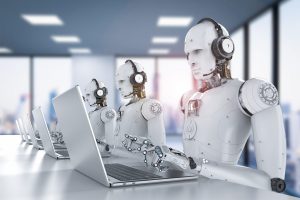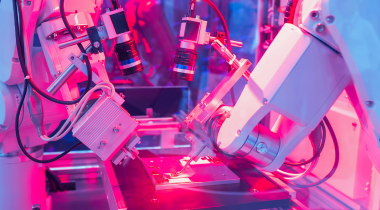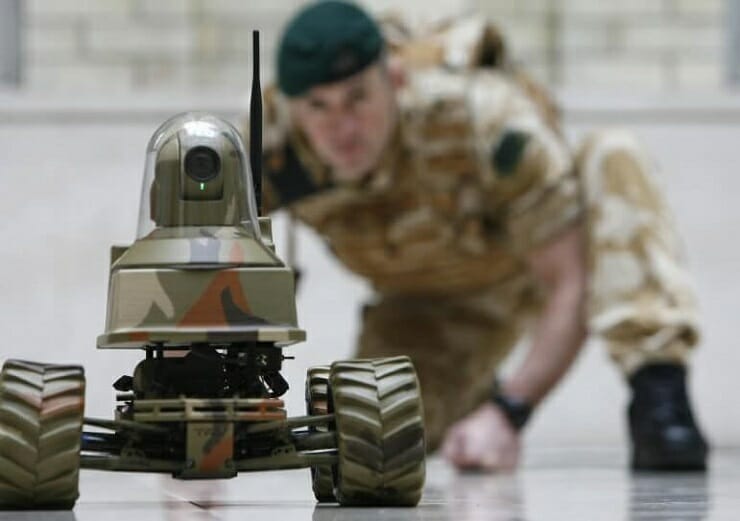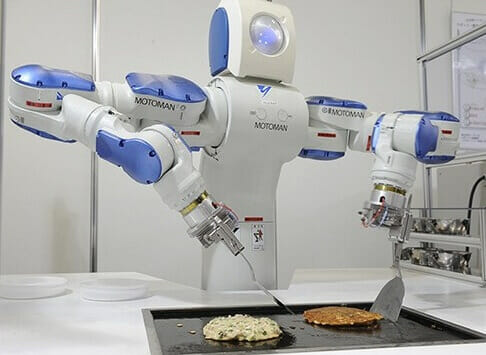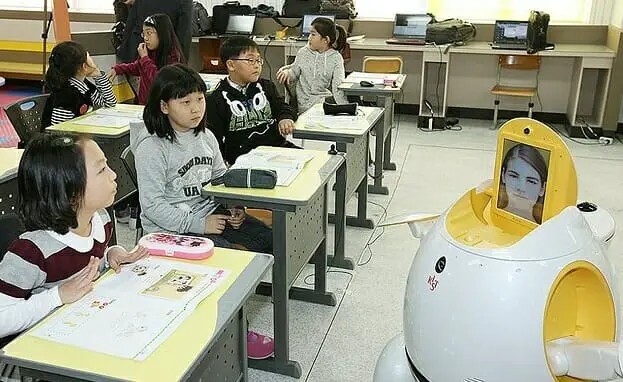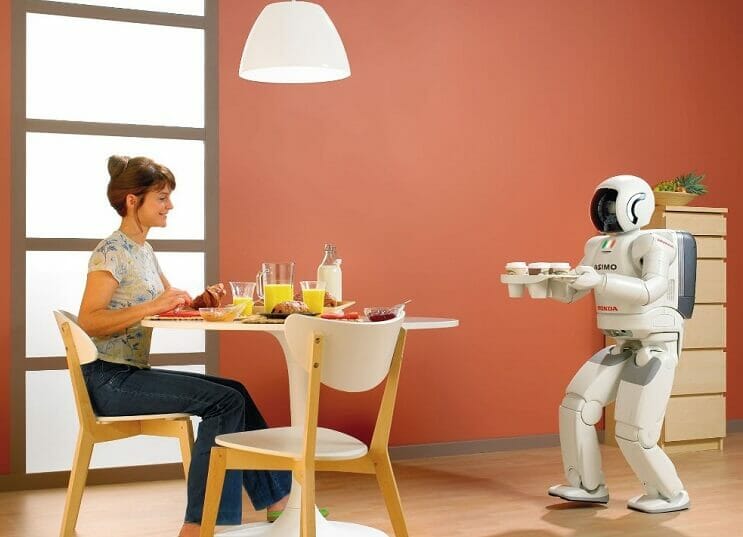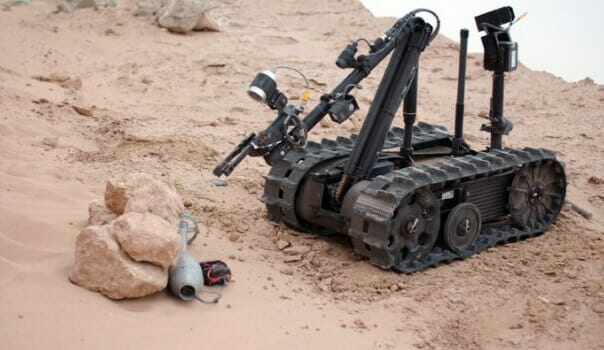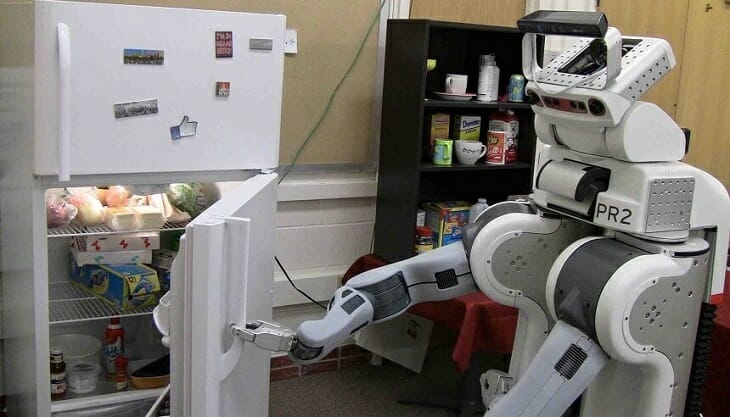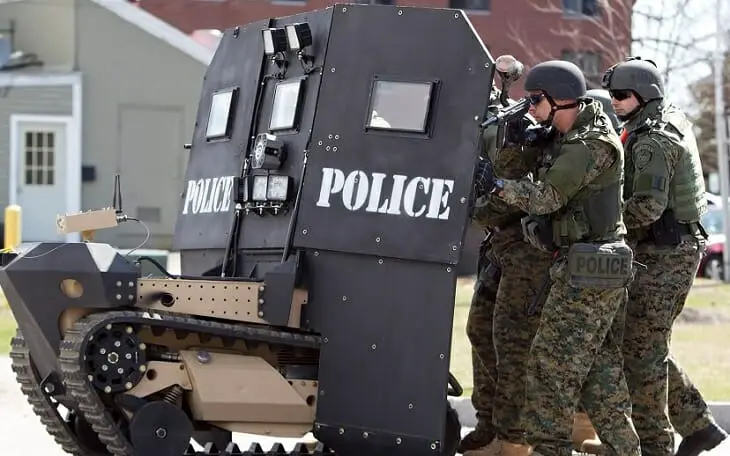What do we use robots for
What do we use robots for
Advantages and disadvantages of using robots in our life
by Heba Soffar · Published May 20, 2016 · Updated May 13, 2022
Robotics or artificial intelligence (AI) are used in manufacturing, in search, in rescue missions & in the military, They are used in factories all over the world and many people recently have lost their jobs as Robots have become more efficient and precise than the humans.
Advantages of robots
Robots can go far down into the unknown places where the humans would be crushed, They can give us the information that the humans can’t get, They can work at places 24/7 without any salary and food, Plus they don’t get bored.
Robots can perform the tasks faster than the humans and much more consistently and accurately, They become more common each and every day, The robotic pets c an help the patients with depression and they keep them active.
Robots
Most of the robots are automatic so, they can move without any human interference, They can entertain us and they can help us in certain tasks, You can send them to a dangerous environment such as the deep sea or the war-zones.
You can use robots to produce the products in the factories such as assembling the cars, They can also be used to build the parts for many products such as the plane parts, the car parts & the construction supplies.
Robots can endure a hostile environment of interplanetary space, They are made that the planetary atmospheres do not affect their physical state & performance, They can replace the human beings in many areas of work, They can shoulder greater responsibilities and they can be programmed to manage themselves.
Robots can be programmed to reach the Earth’s nadir, They can be used to dig for the fuels, They can be used for mining purposes, They can be harnessed for exploring the depths of oceans, They can be used to overcome the limitations that humans have.
Robots can be used in carrying out repetitive & time-consuming tasks efficiently, They are used to do dangerous tasks, They can adjust their parameters like their speed & time, They can act quickly, unaffected by the factors that affect the humans.
Robots do not require to sleep or take breaks, They are able to function without stopping, When employed to carry out dangerous tasks, the risk to the human health & safety is reduced, They can work a long time without service or maintenance and they can be more productive than the people.
Robots can not tremble or shake as the human hands do, They can have much smaller & versatile moving parts than the people, They have performed medical surgeries because they can be faster and more precise than the people.
Robots are designed to work in harsh environments like in space, without the air, underwater & in the fire, They can be used instead of the people when the human safety is a concern, They can come in any size, Whatever size needed for any task can be created.
Robots can do the jobs that the people are unwilling to do, many robotic probes have been sent throughout the solar system to never return back to Earth, They can be stronger than the people, Robots in the warfare eliminate putting more people at risk.
Disadvantages of robots
Robots cost much money in maintenance & repair, The programs need to be updated to suit the changing requirements, the machines need to be made smarter, In case of breakdown, the cost of repair may be very high, The procedures to restore lost code or data may be time-consuming & costly.
Robots can store large amounts of data but the storage, access, retrieval is not as effective as the human brain, They can perform repetitive tasks for a long time but they do not get better with experience such as the humans do.
Robots are not intelligent or sentient, They can never improve the results of their jobs outside of their predefined programming, They do not think, They do not have emotions or conscience, This limits how the robots can help & interact with people.
Robots can take the place of many humans in factories, So, the people have to find new jobs or be retrained, They can take the place of the humans in several situations, If the robots begin to replace the humans in every field, They will lead to unemployment.
Humans fear robots, Robots inspire two types of fear: firstly, that they might take over our jobs, and secondly, that they could take over the world, Robots will steal our jobs, Robots have the effect of increasing productivity rather than eliminating jobs.
Robotics become increasingly present in our everyday life, with household robots, medical, industrial, on production lines, not to mention airports, banks, and hotels, So, Robots may dominate the human species. Robots can operate on the basis of information fed to them through a chip, when one thing goes wrong the entire company bears a loss.
The robot can save time, but it can also result in a lag, It is a machine so you can’t expect too much from them, If the robot has malfunctioned, you need extra time to fix it, which would require reprogramming, If robots would do all the work, and the humans will just sit and monitor them, health hazards will increase rapidly, Obesity will be on top of the list and less labour at workplaces.
You can download the application on google play from this link: Science online Apps on Google play
Презентация по английскому языку «Robots in our life»
Курс повышения квалификации
Особенности подготовки к проведению ВПР в рамках мониторинга качества образования обучающихся по учебному предмету «Английский язык» в условиях реализации ФГОС ООО
Курс профессиональной переподготовки
Английский язык: теория и методика преподавания в дошкольном образовании
Курс повышения квалификации
Современные педтехнологии в деятельности учителя
«Эффективное обучение иностранным языкам дошкольников: профессиональные и личностные компетенции преподавателя»
Учебные задания в аспекте функциональной грамотности школьников в новом учебном году
Открытая сессия для педагогов и родителей
Описание презентации по отдельным слайдам:
Robots in our life
Presentation by students of
9-10 forms
The aim: to find some information about meanings of Robots in our life
The goals:
to learn information about types of robots
to learn the problems of using Robots in different areas of life
to explore the latest achievements of scientists in Robotics
to conduct a survey about the role of robots in our lives
Methods: analysis, synthesis, collecting information
People always try to invent something new that can simplify our life or daily routine or solve some technological or medical problems, for example. Every invention is the important
step of the progress.
Many years ago robots
were something fantastic
and unreal. The idea of
using robots as helpers
in houses or as alternates
of a human being was the
main idea of science fiction.
Nowadays it is quite real.
Introduction
Are Robots so necessary?
People living in modern times have
benefited from many discoveries and inventions
that have enriched the world.
Dedicated scientists spend years and
even a lifetime searching for new scientific
knowledge and discovering new ways to improve
our lives.
The most recent significant
discoverings to benefit humankind in modern
times are in the fields of robotics and
computer technology.
That’s why robots are necessary.
Robots play a large role for humans. They are able to work without stopping and their physical data is much larger than that of a human. Robots can work stably regardless of the day of the week or the time of day. All that makes them more effective than people
MEDICINE: Health care
is one of the most
progressive areas in
which the work of
robots is used.
Currently, robotic surgery
is actively developing.
In medicine, a great
breakthrough has been
achieved since the bionic
prostheses began to be
used, which a person
can control with the help
of his own nervous
system.
Where could they be used for?
Where could they be used for?
SPACE: Space robots are actively used by man in the development of the universe-mechanisms collect soil samples and explore new spaces in conditions of high radiation and extreme temperatures.
SECURITY SYSTEM:
There are military
bases that use
robots that
simulate the actions
of the enemy.
Such training
mechanisms
can reproduce
human habits.
In addition,
there are
intelligence and
combat models.
Where could they be used for?
Who has benefits from using them?
We can use robots as helpers in our houses. Of course, not everyone can afford them. For example, they may be quite expensive. Another reason is that some models of robots may be not mass-consumption products. However, vacuum-cleaning robots are widely used nowadays. They are not the part of science fiction but the real assistants of modern people who are very busy.
Who has benefits from using them?
What do they look like?
Robots can look like
a small insect and
penetrate hard-to-reach
places.
May be similar to any
animal, such as a dog or
cat. Robots can look
like human and very realistic.
There is a huge
variety of robots.
People every day
more and more realize
this sphere.
What do they look like?
The BINA48 was created and
programmed by David Henson
from Terasem Movement.
It is modeled after the
likeness of the co-founder’s
wife Bina Rothblatt.
This intelligent humanoid
robot, created in 2010
is a copy of Bina Rotblatt.
The memories views and
feelings of a woman are
loaded into the brain of
the mechanism. The
real Bina taught the smart
car to speak and move in
her style and also to imitate
mimicry.Android knows how to
keep up a conversation and
joke. Robot vocabulary and
knowledge are updated with
each new conversation
What do they look like?
Sofia was activated on April 19, 2015. She modeled on the actress Audrey Hepburn.
Sophia has an artificial intelligence, equipped with visual processing functions and face recognition technology. Sophia can imitate human gestures and facial expressions and can also answer certain questions and conduct simple conversations on pre-determined topics. In total, Sofia can imitate 60 emotions
What do they look like?
DisAdvantages
Robots have some drawbacks:
They are not very independent.
Also, they can easily break.
Modern robots are hard to assemble and they are very expensive.
They need constant power supplies.
They need human control.
“
”
How do they work?
The robot has software-controlled cameras and sensors that allow it to work in different conditions.
The wheels of the robot are activated using different types of drives.
A robot needs a power source to control these drives. Most robots are either equipped with a battery or work from a power outlet.
To move the robot, the computer activates all the necessary motors and valves.
Most robots can be reprogrammed to change behavior.
Not all robots have a sensor system, and only a few have the ability to see, hear, smell or tast
How do they work?
-Do you like Robots?
-Do you want to have a Robot?
-Are robots our servants or friends?
The idea of robots is quite interesting. The application of them can do good in different fields in the modern life.
In conclusion…
WE SHOULD BE FRIENDS
Рабочие листы и материалы для учителей и воспитателей
Более 3 000 дидактических материалов для школьного и домашнего обучения
«Кинетический имидж учителя и его невербальное влияние на учеников»
Свидетельство и скидка на обучение каждому участнику
«Начало учебного года современного учителя»
Свидетельство и скидка на обучение каждому участнику
What Is Robotics? What Are Robots? Types & Uses of Robots.
35 Robotics Companies on the Forefront of Innovation
At robotics companies across America, the co-mingling of engineering and science is producing some truly innovative products.
18 Companies Turning AI Robots Into Real Life Wins
Robotics is an interdisciplinary sector of science and engineering dedicated to the design, construction and use of mechanical robots. Our guide will give you a concrete grasp of robotics, including different types of robots and how they’re being applied across industries.
Updated by: Jessica Powers | Updated on: July 27, 2022
What Is Robotics?
Robotics is the intersection of science, engineering and technology that produces machines, called robots, that replicate or substitute for human actions. Pop culture has always been fascinated with robots — examples include R2-D2, the Terminator and WALL-E. These over-exaggerated, humanoid concepts of robots usually seem like a caricature of the real thing. But are they more forward thinking than we realize? Robots are gaining intellectual and mechanical capabilities that don’t put the possibility of a R2-D2-like machine out of reach in the future.
What Is a Robot?
As technology progresses, so too does the scope of what is considered robotics. In 2005, 90 percent of all robots could be found assembling cars in automotive factories. These robots consist mainly of mechanical arms tasked with welding or screwing on certain parts of a car.
Today, we’re seeing an evolved and expanded definition of robotics that includes the development, creation and use of bots that accomplish tasks like exploring the planet’s harshest conditions, assisting law enforcement, streamlining surgical procedures and undertaking rescue missions.
Robotics Defined
While the overall world of robotics is expanding, a robot has some consistent characteristics:
We’re bound to see the promise of the robotics industry sooner, rather than later, as artificial intelligence and software also continue to progress. In the near future, thanks to advances in these technologies, robots will continue getting smarter, more flexible and more energy efficient. They’ll also continue to be a main focal point in smart factories, where they’ll take on more difficult challenges and help to secure global supply chains.
The robotics industry is filled with an admirable promise of progress that science fiction could once only dream about. From the deepest depths of our oceans to thousands of miles in outer space, robots will be found performing tasks that humans couldn’t dream of achieving alone.
Types of Robotics
Mechanical bots come in all shapes and sizes to efficiently carry out the task for which they are designed. All robots vary in design, functionality and degree of autonomy. From the 0.2 millimeter-long “RoboBee” to the 200 meter-long robotic shipping vessel “Vindskip,” robots are emerging to carry out tasks that humans simply can’t.
There are five distinct types of robots that perform tasks depending on their capabilities. Below is an outline of these types and what they do.
Pre-Programmed Robots
Pre-programmed robots operate in a controlled environment where they do simple, monotonous tasks. An example of a pre-programmed robot would be a mechanical arm on an automotive assembly line. The arm serves one function — to weld a door on, to insert a certain part into the engine, etc. — and its job is to perform that task longer, faster and more efficiently than a human.
Humanoid Robots
Humanoid robots are robots that look like or mimic human behavior. These robots usually perform human-like activities (like running, jumping and carrying objects), and are sometimes designed to look like us, even having human faces and expressions. Two of the most prominent examples of humanoid robots are Hanson Robotics’ Sophia and Boston Dynamics’ Atlas.
Autonomous Robots
Autonomous robots operate independently of human operators. These robots are usually designed to carry out tasks in open environments that do not require human supervision. They are quite unique because they use sensors to perceive the world around them, and then employ decision-making structures (usually a computer) to take the optimal next step based on their data and mission. One example of an autonomous robot is the Roomba vacuum cleaner, which uses sensors to roam freely throughout a home.
Examples of Autonomous Robots
Teleoperated Robots
Teleoperated robots are semi-autonomous bots that use a wireless network to enable human control from a safe distance. These robots usually work in extreme geographical conditions, weather and circumstances. Examples of teleoperated robots are the human-controlled submarines used to fix underwater pipe leaks during the BP oil spill or drones used to detect landmines on a battlefield.
Augmenting Robots
Augmenting robots, also known as VR robots, either enhance current human capabilities or replace the capabilities a human may have lost. The field of robotics for human augmentation is a field where science fiction could become reality very soon, with bots that have the ability to redefine the definition of humanity by making humans faster and stronger. Some examples of current augmenting robots are robotic prosthetic limbs or exoskeletons used to lift hefty weights.
What Is a Bot? What Is Software Robotics?
Software robotics, also called bots, are computer programs which carry out tasks autonomously. One common use case of software robots is a chatbot. A chatbot is a computer program that simulates conversation both online and over the phone and is often used in customer service scenarios. Chatbots can either be simple services that answer questions with an automated response or more complex digital assistants that learn from user information.
Types of Bots
Software robots only exist on the internet and originate within a computer, which means they are not considered robots. In order to be considered a robot, a device must have a physical form, such as a body or a chassis.
How Do Robots Function?
Independent Robots
Independent robots are capable of functioning completely autonomously and independent of human operator control. These typically require more intense programming but allow robots to take the place of humans when undertaking dangerous, mundane or otherwise impossible tasks, from bomb diffusion and deep-sea travel to factory automation. Independent robots have proven to be the most disruptive to society, as they eliminate certain jobs but also present new possibilities for growth.
Dependent Robots
Dependent robots are non-autonomous robots that interact with humans to enhance and supplement their already existing actions. This is a relatively new form of technology and is being constantly expanded into new applications, but one form of dependent robots that has been realized is advanced prosthetics that are controlled by the human mind.
A famous example of a dependent robot was created by Johns Hopkins APL in 2018 for Johnny Matheny, a patient whose arm was amputated above the elbow. Matheny was fitted with a modular prosthetic limb so researchers could study its use over a sustained period. The MPL is controlled via electromyography, or signals sent from his amputated limb that controls the prosthesis. Over time, Matheny became more efficient in controlling the MPL and the signals sent from his amputated limb became smaller and less variable, leading to more accuracy in its movements and allowing Matheny to perform tasks as delicate as playing the piano.
Best Robotics Companies With Open Roles View Top Robotics Companies Hiring Now
What Are the Main Components of a Robot?
Robots are built to present solutions to a variety of needs and fulfill several different purposes, and therefore, require a variety of specialized components to complete these tasks.
What are the main components of a robot?
However, there are several components that are central to every robot’s construction, like a power source or a central processing unit. Generally speaking, robotics components fall into these five categories:
Control System
Computation includes all of the components that make up a robot’s central processing unit, often referred to as its control system. Control systems are programmed to tell a robot how to utilize its specific components, similar in some ways to how the human brain sends signals throughout the body, in order to complete a specific task. These robotic tasks could comprise anything from minimally invasive surgery to assembly line packing.
Sensors
Sensors provide a robot with stimuli in the form of electrical signals that are processed by the controller and allow the robot to interact with the outside world. Common sensors found within robots include video cameras that function as eyes, photoresistors that react to light and microphones that operate like ears. These sensors allow the robot to capture its surroundings and process the most logical conclusion based on the current moment and allows the controller to relay commands to the additional components.
Actuators
A device can only be considered to be a robot if it has a movable frame or body. Actuators are the components that are responsible for this movement. These components are made up of motors that receive signals from the control system and move in tandem to carry out the movement necessary to complete the assigned task. Actuators can be made of a variety of materials, such as metal or elastic, and are commonly operated by use of compressed air (pneumatic actuators) or oil (hydraulic actuators) but come in a variety of formats to best fulfill their specialized roles.
Power Supply
Like the human body requires food in order to function, robots require power. Stationary robots, such as those found in a factory, may run on AC power through a wall outlet but more commonly, robots operate via an internal battery. Most robots utilize lead-acid batteries for their safe qualities and long shelf life while others may utilize the more compact but also more expensive silver-cadmium variety. Safety, weight, replaceability and lifecycle are all important factors to consider when designing a robot’s power supply.
Some potential power sources for future robotic development also include pneumatic power from compressed gasses, solar power, hydraulic power, flywheel energy storage organic garbage through anaerobic digestion and nuclear power.
End Effectors
End effectors are the physical, typically external components that allow robots to finish carrying out their tasks. Robots in factories often have interchangeable tools like paint sprayers and drills, surgical robots may be equipped with scalpels and other kinds of robots can be built with gripping claws or even hands for tasks like deliveries, packing, bomb diffusion and much more.
Uses of Robots
Robots have a wide variety of use cases that make them the ideal technology for the future. Soon, we will see robots almost everywhere. We’ll see them in hospitals, hotels and even on roads.
Applications of Robotics
Robotics in Manufacturing
The manufacturing industry is probably the oldest and most well-known user of robots. These robots and co-bots (bots that work alongside humans) work to efficiently test and assemble products, like cars and industrial equipment. It’s estimated that there are more than three million industrial robots in use right now.
Logistics Robots
Shipping, handling and quality control robots are becoming a must-have for most retailers and logistics companies. Because we now expect our packages to arrive at blazing speeds, logistics companies employ robots in warehouses, and even on the road, to help maximize time efficiency. Right now, there are robots taking your items off the shelves, transporting them across the warehouse floor and packaging them. Additionally, a rise in last-mile robots (robots that will autonomously deliver your package to your door) ensure that you’ll have a face-to-metal-face encounter with a logistics bot in the near future.
Robots for Home
It’s not science fiction anymore. Robots can be seen all over our homes, helping with chores, reminding us of our schedules and even entertaining our kids. The most well-known example of home robots is the autonomous vacuum cleaner Roomba. Additionally, robots have now evolved to do everything from autonomously mowing grass to cleaning pools.
Travel Robots
Is there anything more science fiction-like than autonomous vehicles? These self-driving cars are no longer just imagination. A combination of data science and robotics, self-driving vehicles are taking the world by storm. Companies like Tesla, Ford, Waymo, Volkswagen and BMW are all working on the next wave of travel that will let us sit back, relax and enjoy the ride. Rideshare companies Uber and Lyft are also developing autonomous rideshare vehicles that don’t require humans to operate the vehicle.
Healthcare Robotics
Robots have made enormous strides in the healthcare industry. These mechanical marvels have use in just about every aspect of healthcare, from robot-assisted surgeries to bots that help humans recover from injury in physical therapy. Examples of robots at work in healthcare are Toyota’s healthcare assistants, which help people regain the ability to walk, and TUG, a robot designed to autonomously stroll throughout a hospital and deliver everything from medicines to clean linens.
Robots have been employed by pharmaceutical companies to help the fight against COVID-19. These bots are now being used to fill and seal COVID-19 testing swabs, and are also being used by some manufacturers to produce PPE and respirators.
History of Robotics
People have been pondering robots since ancient civilizations incorporated myths and beliefs of “thinking machines” into their societies and invented the water clock. Robotics has drastically changed since the time of the Greeks, Romans and Egyptians, but its history is vast. Here’s a look at some of the most important events that shaped the history of robotics.
Six ways robots are used today that you probably didn’t know about
Author
Professor in Robotics, Queensland University of Technology
Disclosure statement
Jonathan Roberts is a Chief Investigator at the Australian Centre for Robotic Vision. He receives funding from the Australian Research Council and the Innovative Manufacturing Cooperative Research Centre.
Partners
Queensland University of Technology provides funding as a member of The Conversation AU.
Languages
How many times in the past week do you think your life was affected by a robot?
Unless you have a robot vacuum cleaner, you might say that robots had no real impact on your life.
But you’re wrong. Let’s take a look at some of the ways robots are being used right now but that you probably have no idea about.
So what is a robot?
Before we start, we need to define what actually is a robot. There is no official definition of what constitutes a robot, but many roboticists (like me) consider it to be a machine that moves, or has moving parts, and that makes basic decisions while interacting with the world.
Hence, your vacuum cleaner that you leave to do its job while you are away is a robot. It senses the world around it and makes driving decisions as it sucks and sweeps.
But your washing machine is not a robot. You tell it how to wash when you select the cycle and it gets on with it. There are grey areas and the definition is debated, but let’s leave it there.
On to your past week.
Food sorting robots
If you eat rice, chances are that every grain you consumed was sorted by a robotic machine with a lightning-fast vision system.
Rice-sorting machines are miracles of automation and most people have no idea they exist. Did you actually think rice grows as uniformly (in colour and shape) as it appears in the bag you buy at the supermarket? It doesn’t.
Every grain of rice passes through a robotic machine that uses very high-speed cameras, lights and a computer. The image of each rice grain is analysed by that computer and a decision is made as to its grade. Jets of air are turned on and off to steer or flick the grain into the correct bin. This happens hundreds of times per second.
In fact, rice is not the only food that is sorted by robots, and the food-sorting market is growing rapidly. Robotic machines are available to sort wheat, pulses and seeds.
Robots for medical training
Did you see a health care professional? If you did, you should have noticed if they were human or a robot. Chances are they were a human.
But did you know that many nurses, paramedics and doctors now train on robot patients.
These training robots can simulate various conditions and give student health workers the ability to practice diagnosis and treatment of various conditions before they go near a real person. You can think of these robotic patients as being like the flight simulators that airline pilots use during their flight training.
Some of these medical training robots are life-sized and look like a real person, but some are more specialised and might be representative of just one part of a person.
Robots for police training
Have you been taken hostage in an armed robbery? I hope not. But if you were, and an armed response team from your police service attended, those police snipers that aimed their red laser dot at the criminals may have been trained using robots.
Sydney-based company Marathon Targets sells a range of highly capable mobile robots that can be shot at by military and police trainees. These robots are armour-plated (for obvious reasons) and can be used to simulate real people (targets) during live-fire training.
Robots for extracting poison
Did you take medication? If it’s medication to prevent malaria or suppress your immune system, those pharmaceuticals may have used scorpion venom as one of the ingredients.
It is quite obvious the extraction of venom from scorpions is quite hazardous to people, but the perfect job for a robot.
Robots down the sewer
You must have used a toilet? Hopefully! We do not often think about our sewers, but when they go wrong, we certainly know about it.
Fatbergs have become a major problem in many cities around the world.
Sewer inspection and maintenance is more important than ever and dome inspection workers now have robots to help them with their difficult business.
Robots and your shopping
Did you go shopping or order anything online? Did you know that many items you buy are partially moved from where they are made to where you receive them by robots?
Some container ports are now partially automated. The huge containers are offloaded from ships by human operators controlling cranes.
Many warehouses are also operated using mobile robots. The best-known example of warehouse automation is Amazon. The retail giant built many of its warehouses specifically for mobile robots that could autonomously transport shelf units.
Amazon felt the robots it used in its warehouses were so vital to its success that it bought the robot company that made them for USD$775 million in 2012.
The robot revolution is now
So that’s just six ways that robots may have affected you in the past week. Of course there are dozens more ways in which robots are likely to have affected your life; this list is just a taster.
The point is that the so-called upcoming robot revolution that is often talked about in the media is already happening. It’s just that most people don’t notice.
What is Robotics? 10 Impacts of Robots in Everyday Life
Last Updated on August 17, 2020 by Stephen Brown
When you see or listen to this word “Robot”, a lot of thing flashes in your mind. You may have some knowledge about this as you have seen Skynet from the film Terminator, Transformers, or from other movies or tv series. Actually, those robots aren’t invented yet. But today, the world is so much dependent on the robot. Robots can do a lot of things that human cannot do or those are dangerous for a human to do. So, what is robotics and how it affects today’s world? This article is based on this question.
What is Robotics
Robotics is a subject in engineering which studies about robots. Robotics is a branch of engineering that deals with the conception, manufacture, design, and operation of Robots. This field includes mechanical engineering, electrical engineering, computer engineering and others.
This technology was introduced to develop machines which can substitute for humans. Robots are that kind of machines that can be used in any situation or for any purposes. But today, many robots are generally used in dangerous environments, manufacturing processes, or that jobs which are dangerous for humans. Robots can be in many forms. But some are made like a human. These robots are called humanoid robots. These robots replicate walking, lifting, cognition and a lot of things that a human can do.
Robotics isn’t invented recently. Science fiction writer Isaac Asimov created his Three Laws of Robotics in 1942. Norbert Wiener formulated the principles of cybernetics in 1948 that is the basis of practical robotics. Fully autonomous robots appeared in the late of 20 th century. The Unimate which was the first digitally operated and programmable robots were installed in 1961. From then, various kinds of robots are being manufactured for various aspects.
Robotics in Our Daily Life
Robots are being used in a lot of branches of our life. Among them, 10 uses of robots in our daily life are described below:
1. Automated Transportation (Self-driving Robot)
The first widespread, high visibility use of mobile robots are seen by Autonomous Self-driving cars. The progress of automated self-driving vehicles development is surprising in the recent 10 or 15 years. New automobiles without robotics are like a computer with wheels. But with robotics, they are more efficient and dangerous free.
Self-driving robots are not that robots that can drive cars. Actually, this means that the cars are made like robots and artificial intelligence is introduced in that cars. In a modern world like in many countries in Europe and America, the automated self-driving vehicle is available. Like buses, trams, trains are automated. But vehicles like cars that run in the streets are not quite general. But recently, Audi, Mercedes, Google are introducing self-driving cars. The day is not that far when human drivers won’t be needed for driving vehicles. As a result, the accidents may not be occurring that much like today.
2. Security, Defense, and Surveillance
The Job of a security, defense, and surveillance robot is normal. It surveys the desired area. It immediately notifies the owner if there is any type of disturbance occurred. This kind of robot is used in the military. Surveillance is a widely used application of drones.
In the military, this type of robot does various kind of jobs. They are used to arm and disarm bombs. They are sent to the desired area to monitor enemy’s activity which is definitely a dangerous job for the soldiers.
For use in human’s daily life, this type of robot monitors home when people are away from their home. This robot helps people to monitor the skies, ground, and water from a remote location. You can control this type of robots from another location to send it to your desired location to monitor the activities of that location. Thus, you can protect your home and properties from being harmed if you are not there to monitor them.
3. Robots Cooking
After passing a full working day in the office, it becomes annoying to motivate yourself to cook a proper delicious meal for you when you get home. Instead of cooking the meal in a proper traditional way, many try to cook the food in a shortcut way which sometimes isn’t healthy and tasty enough. But how it would be if you would have a robotic cooking assistant for you which would make the food as you want?
There are many programmable robots which can cook food according to your choice. You just have to set the quantity of the ingredients of the food. The rest will be done by the robot. Many robots are now introduced which can copy you. All you need is just do the cooking in front of the robot for once. The movement of your body is recorded by the camera. From then, the robot will copy your actions to make that food for you. This kind of robotic cooking assistants is introduced in many hotels and houses.
Some companies manufacture this kind robot. Among them, Moley Robotics, Shadow Robot Companies are quite famous.
4. Medicine
The impact of robotics is undeniable in the field is medicine. Recently, engineers have successfully discovered surgical robots. This success has attracted large financial investment on robots in medical science.
Recently, Google and Johnson & Johnson are working together to create next-generation medical robot system. In the recent past, robots were only used in the clinical system just as assistants. But now, they are introduced as part and parcel of the clinical system. Though it is not possible yet, it is not too far that robots will replace surgeons in surgical operations.
Robot system in established in clinics around the world. So, engineers are working hard to successfully invent micro and nanorobots. Because they are capable of doing things which need precise and accurate performance as a human cannot do that kind of things. For drug delivery system, these robots can locally concentrate therapeutic payload around pathological sites so that they can reduce the dose of administrative drugs and side effects caused by them.
5. Education
Robotics is now called as a General-Purpose Technology. That means it has the potential to alter societies by its impacts on economic and social structures. So, now it is natural to discuss robotics in education.
Many students suffer from various kinds of diseases every day. So, they cannot physically attend the classes. For this reason, they miss lessons. Engineers have made that kind of robots which can help the students attend their classes from afar. The robot performs as a person in the classroom which is controlled by the person himself. Its cameras are his eyes and body is for interacting with other students and teachers. So, the person can see and do everything in the classroom that he wants to do from the hospital or the house.
Autistic students generally find it irritating and confusing when they communicate with other people. The Humanoid robots look like humans. So, it is easy to interact with them as they look like a human. These robots can help the autistic students by teaching social cues, educational lessons. The success is quite good in this field.
Science has made it possible to learn something from a distance place. Technology has already made it possible and will only continue to make it better. Now, teachers can teach a class even not at present in the class. In that case, a telepresence robot does the job. That robot acts like a human and is controlled by the person himself from a distance place. So, students find it interesting and interactive to interact with the person through the robot.
6. Home Maintenance
There are many things that robot can do for home maintenance. But yet, that kind of robots are not that available or if available, they cost much.
7. Doing Dangerous Jobs
There are many dangerous jobs for human in which robots have replaced humans.
8. As a servant
9. Robot as friend
Now, a robot is not only a machine who works for you. Artificial intelligent robots are so smart that they can act as friends. As engineers are always working to make artificial intelligence better, robots are more acting like a human. Some robots monitor you. They which you like or how you like that or which you don’t like. They can do things according to your choice. These make those robots friend.
As an example, Boomer which was a bomb disposal robot was given a military funeral which was being completed with 21-gun salutes. Because the robot had a personality of its own and it saved its human friends’ life on many occasions. So, its comrades felt that they owed him a military send off.
Robots are used as explorers. Many spaceships are operated by robots. It is sometimes a very dangerous job for a human. Robots do this for us. Recently, NASA sent a robot named “curiosity” to explore the Mars. It is not possible for a human.
In many western countries, it often happens that people are choosing robots as their life partner. From this, it can surely be said that present robots can make good friends as human.
10. Crime Fighting
Best Companies that Produce Robots
There are many well-known robot manufacturing companies except these.
Cons of Depending on Robots
Humans are still considered as more efficient than robots in various aspects. Because humans are intelligent, emotional, decision maker. So, they can handle a lot of unexpected situations that robots cannot.
Conclusion
Robots are blessings for human in various aspects. The application of robotics is too vast to describe. It is hard to find any factory working without robots. Robots are being used on many occasions in our daily life. But depending on robots too much can cause damage to human strengths. So, it will be wise for humans to research a lot about using robots in various sectors before it is too late. This article was written based on the topic “what is robotics”. If you have already gone through the whole article, you now have a lot of knowledge about robotics and its various sectors.
